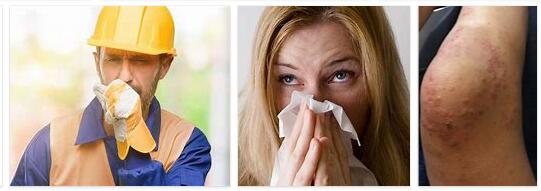Occupational allergies are triggered by occupational-specific allergens. In order to combat occupational allergies such as baker’s asthma or hairdresser ‘s eczema, allergen avoidance is often necessary.
What are occupational allergies?
According to fun-wiki.com, occupational allergies are allergic diseases that manifest themselves as a result of a certain occupational activity due to contact with occupational-specific substances. Examples of such occupational allergies are baker’s asthma and hairdresser’s eczema.
The so-called baker’s asthma is an allergic respiratory disease that mainly affects bakers. Hairdressing eczema is an allergic skin condition that is one of the most common occupational allergies among hairdressers.
A hairdresser’s eczema occurs in the majority of cases on the hands of those affected. Statistically speaking, female hairdressers are twice as likely to suffer from hairdressing eczema as men. In many cases, occupational allergies can mean that those affected have to orientate themselves differently at work or are retired early.
Causes
Occupational allergies are usually caused by occupation-specific frequent contact with certain working materials. In the case of occupational allergies, frequent contact with actually non-toxic substances leads to increasing sensitization, from which occupational allergies can eventually develop.
It is also possible that those affected already had certain latent allergies before they started their career, but that they only become acute as occupational allergies due to the increased number of substance contacts. Doctors also assume that there is a genetic susceptibility to the development of certain occupational allergies. It is therefore not always possible to make a clear decision as to whether the contact substances responsible for occupational allergies are really the cause of these occupational allergies or are simply their triggers.
Specific triggers that can lead to baker’s asthma include flour and enzymes. Fine flour dust is often distributed in the air in bakeries and can thus lead to baker’s asthma. Hairdressing eczema is often triggered by substances such as hair shampoo, means for coloring or bleaching the hair, colors or even rubber gloves that are used.
Symptoms, ailments & signs
As a rule, the symptoms and complaints of occupational allergies depend very much on the exact allergy. For this reason, no general prediction of the symptoms can be made here. In some cases, however, the symptoms are so severe that they can ultimately lead to the death of the person concerned. In baker’s asthma, those affected primarily suffer from severe shortness of breath.
This leads to breathing difficulties and continued fatigue and exhaustion of the patient. Often there are also sleep problems. Many patients also have abnormal breathing sounds. A cough phlegm comes out and there is a shortness of breath, so that the patient load is considerably reduced.
Many affected people can no longer pursue their profession due to the baker’s asthma. With hairdresser’s eczema, patients often suffer from reddening of the skin. The skin itself is covered with itching, which is further aggravated by scratching. A severe rash can also appear on the skin and have a negative effect on the quality of life of the person affected.
The hairdresser’s eczema often leads to psychological complaints or depression. Many patients no longer feel beautiful because of the symptoms and therefore suffer from inferiority complexes or from a reduced self-esteem.
Diagnosis & course
In order to be able to clearly diagnose occupational allergies such as baker’s asthma or hairdresser’s eczema, a competent specialist must usually first be consulted if symptoms occur; if baker’s asthma is suspected, this can be, for example, a specialist in lung diseases, if hairdresser’s eczema is suspected, a dermatologist.
The doctor usually first asks the person concerned about their medical history as well as their professional situation and workplace. Specific allergy tests follow to determine any occupational allergies. On the basis of the medical assessment, professional associations often decide whether there are actually occupational allergies.
In many cases, baker’s asthma cannot be completely cured, but it can be significantly improved by avoiding allergenic substances and using appropriate therapy. Hairdresser’s eczema can recede after avoiding substance contact, but usually occurs again when there is renewed contact.
Complications
A complication of the baker’s asthma is the unspecific bronchial hyperreactivity. This triggers sudden breathing difficulties due to the inhalation of certain substances, but subsides after a few hours. The respiratory disease caused by the allergy can also lead to acute or chronic complaints.
The patient then suffers from severe breathing difficulties, which severely restrict him in everyday life and consequently in his job. With this course of the disease, baker’s asthma can even be life-threatening: The reduced oxygen supply, for example due to severe swelling of the airways, can lead to a failure of the cardiovascular system.
A supply of medication or oxygen is then essential. The respiratory diseases caused by occupational allergies sometimes also lead to an increased incidence of viral or bacterial bronchial diseases. These also heal more slowly than in patients who do not suffer from baker’s asthma.
The hairdresser’s eczema becomes a major burden when the skin irritations occur in quick succession. Severe eczema is also a sign of a complicated course of the disease. Medical measures are absolutely necessary in the case of frequent redness, itching and rashes. The symptoms of this occupational allergy do not subside independently in this acute stage, but can be treated.
When should you go to the doctor?
If allergic symptoms persist in the workplace, a doctor should be consulted. The doctor can use an allergy test to determine whether it is a typical occupational allergy and suggest further measures. A visit to the doctor is recommended at the latest when the symptoms affect performance or well-being. For example, a strong cough, a runny nose or reddening of the skin that cannot be traced back to any other cause should be clarified as a matter of principle.
If the symptoms can be clearly traced back to a specific substance in the workplace, an immediate sick leave is required. In cooperation with the doctor, the relevant insurance offices should also be contacted in order to guarantee financial security during the absence from work.
An emergency doctor should be called in the event of acute asthma attacks and circulatory problems at work. Those affected should leave the workplace immediately and receive medical treatment for the symptoms in order to prevent their general condition from deteriorating. In severe cases, first aid measures must be provided until the rescue service arrives.
Treatment & Therapy
In the course of therapy for occupational allergies such as baker’s asthma and hairdresser’s eczema, approaches are often combined that are used to combat the causes and symptoms:
Depending on the form and severity of the existing contact allergies, it may be necessary to avoid contact with substances that trigger the occupational allergies in order to combat the cause. For this purpose it may be important to subject the individual workplace to various protective measures.
A supplementary fight against symptoms in baker’s asthma and hairdresser’s eczema can be done by administering various medications. In order to treat hairdressing eczema, for example, cortisone preparations are often used, which are regularly applied in the form of creams or powder to the areas of skin affected by hairdressing eczema.
Baker’s asthma can also be treated symptomatically with long-term administration of cortisone (also known as glucocorticoid in medicine). The cortisone is taken in here, for example via an inhaler, so that the airways can be reached in a targeted manner.
Outlook & forecast
Since occupational allergies are triggered by certain substances that those affected have to deal with at work, the prognosis is unfavorable if they continue to expose themselves to these substances. If a baker has an allergic reaction to components of a baking mix, it usually only helps to avoid these substances or to greatly reduce contact, which is hardly possible in the bakery.
It is similar with hairdressers. As long as you reduce or avoid contact with the allergenic substances, the symptoms decrease. In both professional groups, however, the symptoms reappear immediately when they come into contact with the allergy triggers again.
A baker’s asthma can be life-threatening due to the breathing difficulties, because the swelling of the airways can lead to cardiovascular failure. In this case, oxygen must be supplied immediately. In addition, the allergy increases the susceptibility to viral or bacterial bronchial infections.
In hairdressers, contact with the allergenic substances usually leads to contact eczema on the hands and permanent contact does not reduce the symptoms. If only the hands are involved, it can sometimes be enough to wear gloves for certain jobs such as dyeing or perming. In worse cases, both professional groups have to change jobs.
Prevention
It is difficult to prevent occupational allergies. In order to limit the risk of occupational allergies, however, it can make sense to undergo appropriate allergy tests before choosing a career in order to be able to determine any allergies that are present. If allergies or a high susceptibility to allergies are already known, it may be advisable to avoid occupations in which there is frequent allergen contact in order to avoid occupational allergies.
Aftercare
For the follow-up care of an occupational allergy, it is crucial to avoid the allergenic substance. In the case of baker’s asthma and hairdresser’s eczema, it is often not possible to change the workplace in such a way that the person concerned does not come into contact with the allergens. In this case, a professional reorientation is an option. The allergy sufferer is looking for another job, completing further training or retraining in order to be able to carry out a new job later in which he is not confronted with the allergens.
Vocational rehabilitation can be financially supported by the statutory accident insurance or another provider. It is considered an achievement for participation in working life. In order for financial help to be granted, a professional opinion is usually required and the allergy sufferer must submit a corresponding application. The doctor who diagnoses the occupational allergy usually discusses the specific course of action with the patient.
The duration of vocational rehabilitation can vary. Some measures are relatively short courses that only take a few weeks, while other measures are designed for half a year or a full year. Completely new vocational training can also take a long time. Vocational rehabilitation is carried out by recognized institutions.
You can do that yourself
Occupational allergies such as baker’s asthma or hairdresser’s eczema can have a significant impact on everyday working life, but also on the leisure life of those affected. Anyone who repeatedly struggles with occupational allergies in everyday life should consider whether a change of occupation would not make sense. If a change is not possible, contact with allergens should be minimized or completely prevented if possible.
In the hairdressing profession, wearing gloves should become a habit. If a baker is equipped with a face mask at work, he can protect himself from the dust in the bakery. Anyone who works as a baker should also ensure that the air polluted by aggressive flour dust is cleaned and, as a result, that dust is relieved. The air can be cleaned using a suction device that filters the polluted room air.
As a preventive measure, hairdressers should take good care of the skin in advance so that they can better protect the skin from the outset and allow skin problems to heal. If the self-help measures do not show great success in working life, an in-house switch to other activities can also be considered. In this way, contact with the triggering allergens and the associated symptoms could be reduced in order to increase the quality of life of those affected and their enjoyment of the job again.



